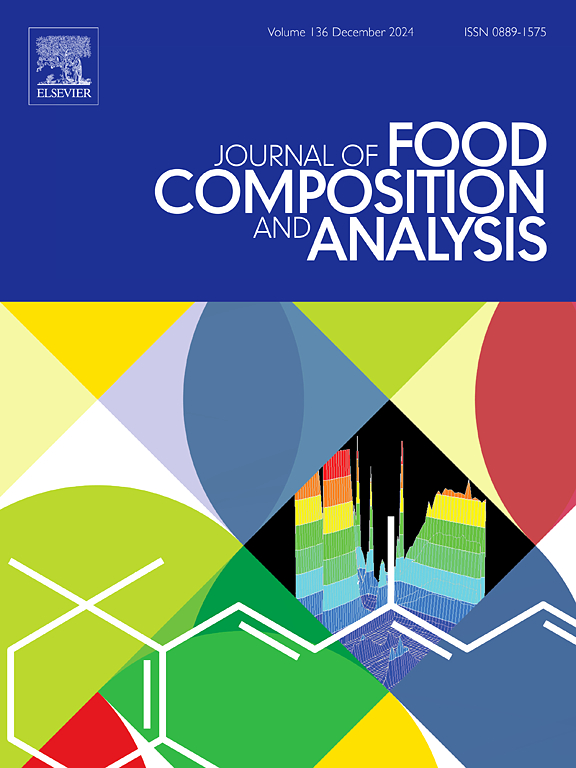利用高光谱成像和机器学习快速无损检测掺假小麦粉的研究
IF 4.6
2区 农林科学
Q2 CHEMISTRY, APPLIED
引用次数: 0
摘要
检测掺假小麦粉对公众健康至关重要。本研究旨在建立一种基于高光谱成像和机器学习的小麦粉掺假检测模型。利用高光谱相机采集了不同发霉程度和发芽率的小麦粉的高光谱图像。为了提高原始光谱数据的质量,对原始光谱数据进行了多种预处理。利用无信息变量消除(UVE)、竞争自适应重加权采样(CARS)和逐次投影算法(SPA)选择特征谱带。采用随机森林回归(RFR)、梯度增强回归(XGBR)等3种模型建立优化的定量分析模型。结果表明,对于霉变小麦粉,所有模型的R²值均在0.95以上。特别是,RFR和XGBR的组合产生的R²值超过0.99,均方根误差(RMSE)值低于0.02。发芽小麦粉的检测性能略低,但部分模型仍能达到0.95以上的R²值。此外,通过光谱可视化分析生成直观的热图,说明了样品中劣质成分的空间分布。这项研究证实了使用高光谱成像和机器学习快速、无损检测掺假小麦粉的可行性。本文章由计算机程序翻译,如有差异,请以英文原文为准。
Research on rapid and non-destructive detection of adulterated wheat flour using hyperspectral imaging and machine learning
Detection of adulterated wheat flour is crucial for public health. This study aims to establish a detection model based on hyperspectral imaging and machine learning for identifying wheat flour adulteration. Hyperspectral images of wheat flour with different degrees of mold and germination were collected by a hyperspectral camera. The raw spectral data were preprocessed with various methods to enhance quality. Uninformative Variable Elimination (UVE), Competitive Adaptive Reweighted Sampling (CARS), and Successive Projections Algorithm (SPA) were utilized to select feature spectral bands. Random Forest Regression (RFR), Gradient Boosting Regression (XGBR), and other three models were used to establish optimized quantitative analysis models. The results showed that, for moldy wheat flour, all models achieved R² values above 0.95. In particular, the combination of RFR and XGBR yielded R² values exceeding 0.99 and root mean square error (RMSE) values below 0.02. The performance for germinated wheat flour detection was slightly lower, but some models still achieved R² values above 0.95. Furthermore, spectral visualization analysis was performed to generate intuitive heat maps, illustrating the spatial distribution of inferior components in the samples. This study confirms the feasibility of using hyperspectral imaging and machine learning for rapid, non-destructive detection of adulterated wheat flour.
求助全文
通过发布文献求助,成功后即可免费获取论文全文。
去求助
来源期刊

Journal of Food Composition and Analysis
工程技术-食品科技
CiteScore
6.20
自引率
11.60%
发文量
601
审稿时长
53 days
期刊介绍:
The Journal of Food Composition and Analysis publishes manuscripts on scientific aspects of data on the chemical composition of human foods, with particular emphasis on actual data on composition of foods; analytical methods; studies on the manipulation, storage, distribution and use of food composition data; and studies on the statistics, use and distribution of such data and data systems. The Journal''s basis is nutrient composition, with increasing emphasis on bioactive non-nutrient and anti-nutrient components. Papers must provide sufficient description of the food samples, analytical methods, quality control procedures and statistical treatments of the data to permit the end users of the food composition data to evaluate the appropriateness of such data in their projects.
The Journal does not publish papers on: microbiological compounds; sensory quality; aromatics/volatiles in food and wine; essential oils; organoleptic characteristics of food; physical properties; or clinical papers and pharmacology-related papers.
 求助内容:
求助内容: 应助结果提醒方式:
应助结果提醒方式:


